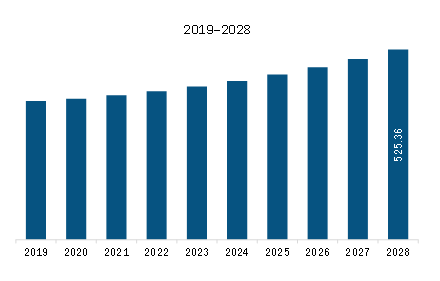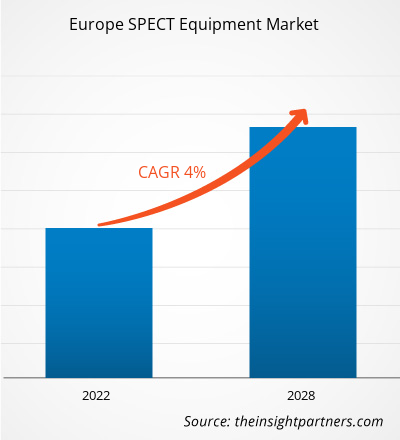The SPECT equipment market in Europe is expected to grow from US$ 398.87 million in 2021 to US$ 525.36 million by 2028; it is estimated to grow at a CAGR of 4.0% from 2021 to 2028.
Gallium-67 is of a gold standard for tumour diagnosis and staging. Hybrid imaging using Ga-67 SPECT/CT enables the localization of lymphoma lesions. Ga-67 is a primarily used agent for the imaging of inflammation, because it has the ability to accumulate non-specifically in inflamed areas as a metal-transferrin complex, followed by further binding to transferrin receptors. Some of the market players, which provide Gallium Citrate GA-67 are Lantheus Medical Imaging and Mallinckrodt Nuclear. Diagnostic imaging has gained a significant role in the management of patients who are suffering from cancer and has made an additional step forward with the introduction of fusion techniques into the field. SPECT technology provides hybrid images of two independent modalities, a functional scintigraphic technique and an anatomical procedure, yielding a superior imaging study. Scintigraphy is based on the use of single-photon or positron-emitting tracers providing a description of function or processes, whereas computed tomography (CT), ultrasound, or magnetic resonance imaging (MRI) depict the precise localization and type of morphological changes that have occurred in the lesions. The recent introduction of a hybrid imaging device containing a low dose CT system and a gamma camera on a single gantry enabled the sequential acquisition of the two imaging modalities, with the subsequent merging of data into a composite image display.
Countries in the European regions were greatly affected due to the COVID-19 pandemic, particularly diagnostic practice. According to the findings published on PubMed, the pandemic posed a significant challenge to NM departments, and every center in Europe witnessed a workforce loss. To prevent COVID-19 transmission, NM agencies implemented restrictions such as postponing non-high-priority procedures. Due to COVID-19, several departments encountered delays in receiving radiopharmaceuticals, which are used in SPECT equipment, as well as technical help. As a result, the pandemic reduced the number of diagnostic and therapeutic NM operations performed, as well as the degree of care provided to patients with diseases other than COVID-19, such as cancer or acute cardiovascular disease. According to the results of the British Nuclear Medicine Society (BNMS) COVID-19 survey, around 97% of NM departments introduced procedures to limit SARS-CoV-2 transmission; at 68% of sites, standardized operating procedures were developed for running departments in pandemic situations. As per the global survey by Freudenberg et al., around 15% of the respondent departments modified working hours for less than 20% of the staff and reported a mean decline of 54.4% in diagnostic procedures. Nuclear scans decreased by a mean of 36%; thyroid scans decreased by 67%; myocardial studies by 66%; bone scans by 60%; lung scans by 56%; and sentinel lymph node procedures by 45%. Nearly all (97%) participating centers in the survey from Germany, Austria, and Switzerland reported a decline in diagnostic NM procedures. In addition, nuclear cardiology was one of the most affected branches of NM during the COVID-19 pandemic in the region. All non-urgent examinations were postponed, and a decrease in 32% and 31% of activity was observed in NHS England PET/CT services in April and May 2020, respectively. Apart from this, new findings supporting COVID-19 diagnosis are expected to accelerate the growth of SPECT Equipment in the region. With the role of SPECT in the COVID-19, the research studies can also pave the way in combating other epidemics in the future.
With the new features and technologies, vendors can attract new customers and expand their footprints in emerging markets. This factor is likely to drive the SPECT equipment market. The Europe SPECT equipment is expected to grow at a good CAGR during the forecast period.
Europe SPECT Equipment Market Revenue and Forecast to 2028 (US$ Million)

- This FREE sample will include data analysis, ranging from market trends to estimates and forecasts.
- This FREE sample will include data analysis, ranging from market trends to estimates and forecasts.
Europe SPECT Equipment Market Segmentation
Europe SPECT Equipment Market – By Type
Europe SPECT Equipment Market – By Type
- Hybrid SPECT
- SPECT-CT
- SPECT-MR
- Standalone SPECT
Europe SPECT Equipment Market – By Radioisotopes
- Iodine-123
- Technetium-99m
- Xenon-133
- Thallium-201
- Ra-223
- Ga-66
- Other Radioisotopes
Europe SPECT Equipment Market – By Application
- Seizures
- Stroke
- Stress Fractures
- Infections
- Tumors
- Others
Europe SPECT Equipment Market – By End User
- Hospitals
- Imaging Centers
- Others
Europe SPECT Equipment Market- By Country
- Germany
- France
- UK
- Italy
- Spain
- Rest of Europe
Europe SPECT Equipment Market-Companies Mentioned
- Bracco Imaging S.p.A.
- Bruker Corporation
- Cardinal Health, Inc
- Curium
- Lantheus Medical Imaging Inc.
- Mediso Ltd.
- MiE GmbH
- NTP RADIOISOTOPES
- Spectrum Dynamics Medical
Europe SPECT Equipment Report Scope
| Report Attribute | Details |
|---|---|
| Market size in 2021 | US$ 398.87 Million |
| Market Size by 2028 | US$ 525.36 Million |
| Global CAGR (2021 - 2028) | 4.0% |
| Historical Data | 2019-2020 |
| Forecast period | 2022-2028 |
| Segments Covered |
By Type
|
| Regions and Countries Covered | Europe
|
| Market leaders and key company profiles |
- Historical Analysis (2 Years), Base Year, Forecast (7 Years) with CAGR
- PEST and SWOT Analysis
- Market Size Value / Volume - Global, Regional, Country
- Industry and Competitive Landscape
- Excel Dataset
- Neurovascular Devices Market
- Bioremediation Technology and Services Market
- Employment Screening Services Market
- Piling Machines Market
- Cosmetic Bioactive Ingredients Market
- Aquaculture Market
- Airport Runway FOD Detection Systems Market
- Fishing Equipment Market
- Clear Aligners Market
- Online Exam Proctoring Market

Report Coverage
Revenue forecast, Company Analysis, Industry landscape, Growth factors, and Trends

Segment Covered
This text is related
to segments covered.

Regional Scope
North America, Europe, Asia Pacific, Middle East & Africa, South & Central America

Country Scope
This text is related
to country scope.
Trends and growth analysis reports related to Life Sciences : READ MORE..
- Bracco Imaging S.p.A.
- Bruker Corporation
- Cardinal Health, Inc
- Curium
- Lantheus Medical Imaging Inc.
- Mediso Ltd.
- MiE GmbH
- NTP RADIOISOTOPES
- Spectrum Dynamics Medical



 Get Free Sample For
Get Free Sample For